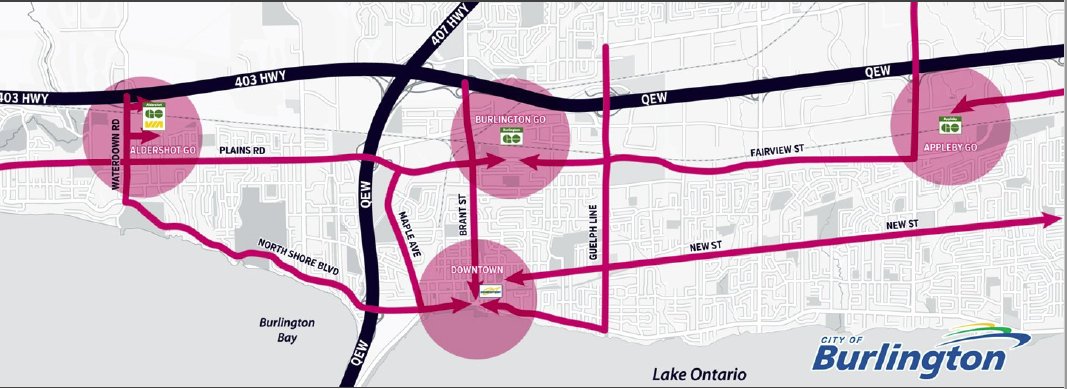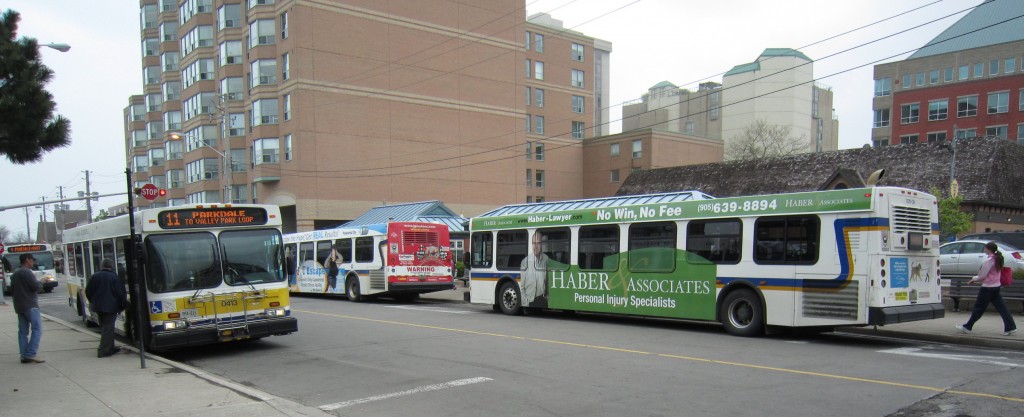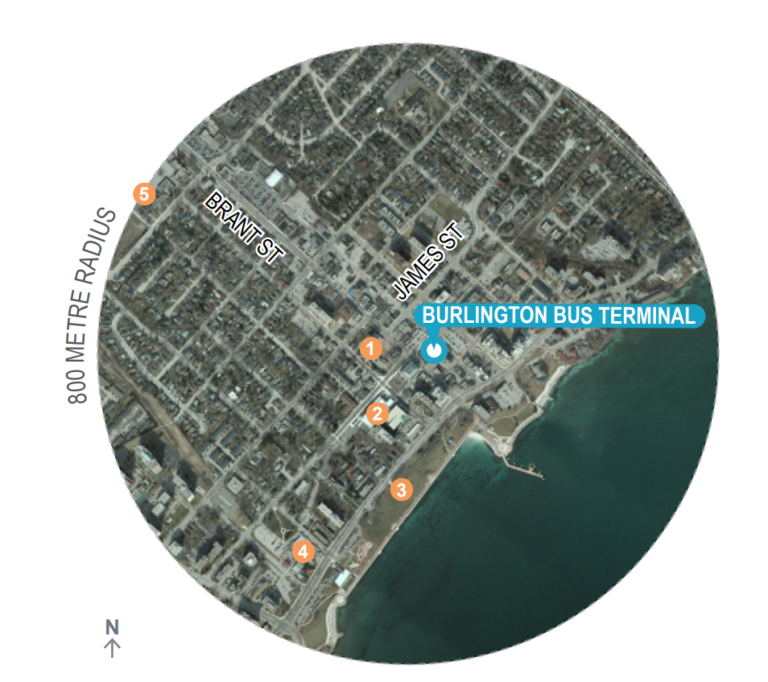 By Pepper Parr
By Pepper Parr
October 5th, 2018
BURLINGTON, ON
Ward 2 candidate Roland Tanner has done his homework.
There has been confusion and different opinions on just what the city can do about the location of the mobility hubs – there are four of them.
Location hubs are locations with significant levels of planned transit service as identified by the regional planning transportation agency Metrolinx under The Big Move.

The city has four mobility hubs. Three , those at Go stations are named as gateway hubs. The hub downtown is referred to as an anchor hub.
There are some people who feel that the locating of a mobility hub in the downtown core is being used by some developers as a pretext to convincing city council to approve high rise towers.
Tanner did what any good researcher does: ask questions.
Tanner reports that “MPP Jane McKenna’s office yesterday confirmed to me that Burlington City Council has complete control over mobility hubs. According to this opinion, the city can choose to remove the mobility hub designation in downtown without reference to the province.
“Yesterday morning I emailed MPP McKenna’s office with this question.
“Can you give me the government’s and MTO’s perspective on the designations regarding the urban growth centre and Metrolinx mobility hubs in downtown Burlington, and whether the municipality has the ability to request that the locations be lifted, modified or moved? Or does the ability to change the designations lie entirely with the municipality as part of its ability to modify its own Official Plan?”
“This is the reply I received from MPP McKenna’s office some hours later:
“It requires a local Municipal Council decision to change the designation in the official plan (provided it is currently designated in the official plan).
There is no specific Provincial requirement to designate the mobility hub that our MTO team is aware of.”
“What does this mean asks Tanner
“The MTO (Ministry of Transport) is responsible for Metrolinx. Burlington’s two mobility hubs in Ward 2 are recognized as Metrolinx anchor and gateway hubs under ‘The Big Move’. The MTO has clearly now stated its opinion that Burlington, and Burlington alone, has the ability to decide the location of its mobility hubs.

Most people see the bus stop on lower John street as a place to transfer from one bus route to another. The city saw it as an anchor mobility hub – that definition gave developers a reason to apply for more density – higher buildings.
“This suggests Burlington has the power to remove the ‘anchor mobility hub designation’ from downtown. I am now seeking urgent clarification from the City of Burlington as to their position in light of the MTO assessment. I will update residents as soon as I receive a reply.
“Some weeks ago, when I submitted a similar question to the city about the process for removing designation of a mobility hub, I received this reply:
“There is no legal framework that exists to challenge in force provincial planning policy.”
Burlington downtown ‘Anchor Mobility Hub’.
“Anchor hubs are major transit points where multiple modes of transit meet – like Union Station, or Pearson Airport. It is currently a mystery as to how the downtown hub was designated an anchor hub.
“While this statement is certainly true in a technical sense, it did not answer the intent of the question as to whether Burlington has the power to modify the designation given to mobility hubs and the urban growth centre. It seems that MPP McKenna and the MTO have now provided their interpretation.
“Anchor mobility hubs are intended to be major transportation points where multiple modes of transportation meet – buses, trains, planes, etc. Lester B Pearson and Union Station are anchor mobility hubs. The St John’s St bus station does not, by any reasonable interpretation of the phrase, amount to a major transportation hub with multiple transportation nodes coming together.

Burlington downtown ‘Anchor Mobility Hub’. Anchor hubs are major transit points where multiple modes of transit meet – like Union Station, or Pearson Airport. It is currently a mystery as to how the downtown hub was designated an anchor hub.

Roland Tanner
“While the intention of placing the bulk of a growing population near transit is absolutely the right idea, and one I entirely support, downtown has never met the criteria for such designation. Having two Metrolinx mobility hubs in Ward 2, closer than anywhere outside downtown Toronto, while lacking anything approaching the transport infrastructure needed at the ‘anchor hub’ downtown, is a mistake. It is a mistake which has led to the widespread public unease which is being seen at this municipal election.
“The whole of Hamilton has just two Metrolinx mobility hubs. Oakville has one. Milton has one.
“So why does Ward 2 have the same number of Metrolinx mobility hubs as some major cities, and more than others? Perhaps we’ll never know – the entire process by which the mobility hubs were designated appears unclear.
“We have over-designated our ward for growth, with the result that change is happening far beyond what is reasonable or what the community wishes to see. It now appears, according to the provincial government, that we have the power to fix the problem.”
Expect Tanner to do something about fixing what he sees as a serious problem.



















Something that people keep overlooking is that the absence of an OP is what got us in the 23 storey mess in the first place. It took us 6 years to develop this OP and now it is with the Region for approval. If the newly elected council wants to amend and rip apart the new OP how long will that take? Another 6 years? Guess what happens in the mean time…all of the development applications appeal and since we have no plan in place, they go to LPAT and you know what happens there. The province wants us to grow so LPAT says sure you can have 23 storeys…23 for you, 23 for you, 23 for you…We need the OP in place ASAP so that we can get all of our ducks in a row and have a leg to stand on when development proposals come in above the allotted height limits. The plan may have its flaws but having no plan provides much higher exposure and keeps the flood gates open to more OVER development. We need to take the power back and we cannot do that without a plan.
Gary gets it right and, sorry, Tom you get it wrong.
The Downtown and Burlington GO hubs are provincially designated mobility hubs. Downtown is an anchor hub and Burlington GO a gateway hub. Read the Big Move to get the definitions.
Being provincially designated, removing the Downtown hub designation will not be so simple. This will have to go through several levels phases and levels of government.
First new council would have to amend the OP, which most likely cannot occur for a couple of years. Next that new OP would have to go through the regional level, adding at least another 6 months to the process. This then would have to go through the provincial Regional Trensportation Plan review. A strong case would have to be presented and it is important to note that the anchor hub would have to be moved, not removed.
Since it would have to be moved, where in Burlington should the anchor hub be located? Note that this would mean moving the Urban Growth Center first, a process in itself.
I will have a look to see what the Big Move says, and you and Gary may be right in the end about the difficulty of having this Downtown designation changed. I would say maybe not easy, but not impossible with political will and desire. I was really trying to raise the issues of discretion and flexibility.
But besides this, I don’t believe the balance of my comment is wrong as you seem to imply with your sweeping use of the “wrong” word. The City information is not wrong, just not explanatory enough. I think there is far too much uncertainty, contingency and absence of information to say anyone is wrong.
For example, the City info I enclosed in my comment was not clear on the point at issue here, as it also called the Downtown a MTSA. But it was clear enough that the Downtown is not the same designation as the Burlington GO station.
Also keep in mind that the OP was adopted by Council without the Transportation and Mobility Hubs plans. They are not complete and due processed through public and Council reviews, debate and approval. I would say that this has a significant bearing on the matter before us.
The City also indicated (I copy and paste from my previous comment) – “Through a subsequent opportunities and constraints study undertaken by the City in 2014, the City began to adopt the term Mobility Hub when referring to all four of the City’s MTSAs given the City’s long-term vision for these areas.” This appears to say that the City had choices in the designation of Downtown and the other two MTSA.
Further, the City information below also says “Therefore, to summarize, Metrolinx’s definition of ‘mobility hub’ (including gateway and anchor hubs) are for Metrolinx’s own infrastructure investment and long-term transportation network planning purposes while the City’s use of MTSA and mobility hub definitions are interchangeable.”
This does not say that there are specific provincial mandates attached from the Places to Grow plan that appears from the political conversation to be the governing document.
I have also heard that the Downtown designation was supposed to come with a $20 million grant from Metrolinx, as part of their investment in the transportation network purposes as above, but there is no word on that money for the City that I know of. So to me this implies another element of discretion.
This City information says the Hubs terminology are for Metrolinx purposes, while the City uses both terms interchangeably, at their discretion it appears. A problem is that these different Hubs designations have different development and density targets, and this is not mentioned by the City piece or by you in your comment. And these density targets are not cast in stone, but can be flexible.
Anyways, the real nub of my comment did not hinge on the ease or difficulty of removing or changing the Downtown designation. Gary made a good point from experience and study, and you concur with him, so it is worth looking further into this to see what this actually entails from officials in charge.
The point I was trying to raise is the difference in density targets between a full blown Burlington GO train designation and the other 3 MTSA of Downtown, Aldershot and Appleby.
These 3 have lesser density targets as MTSA specified at 150/ha as per information from the City and Metrolinx.
From other information I included in my comment, we appear to have already reached that target, and so I wrote about the implications of that in my comment below.
Although I didn’t say much about the ease of changing the OP, you saying it is very difficult does not conform with the facts of the process.
Once the Region approves the OP the City Council, with a majority, can amend and change it anytime thereafter limited by possible existing LPAT appeals.
We received the following explanation of this from the Region (Art Zuidema) –
“In response to your follow-up question, once the new Official Plan has been approved by the Region (if there are no appeals) or the LPAT (if there are appeals and the LPAT has the jurisdiction to make this decision), there is a 2-year freeze on further private applications to amend the official plan. However, after the new Official Plan has been approved, Burlington City Council may initiate its own official plan amendment to amend the new Official Plan, or may by resolution declare that certain requests to amend the new Official Plan are permitted within the 2 year period. City Council at this time cannot make changes to the new Official Plan as it is still with the Region for approval.”
(As to whether future amendments to the new Official Plan once it is approved can be appealed to the LPAT, this depends on the nature of the future amendment. There are certain instances when official plan amendments may be exempt from appeal (please see “Limitations on Appeals” in the Citizen guide on Official Plans here: https://www.mah.gov.on.ca/Page1759.aspx ), however most amendments would still have the potential to be appealed.”
I have other explanations of this I can share.
The point being that the rest of my comment below follows from this information on density targets and the ability of Council to change the OP as soon as it is approved by the Region.
Of course, this does not answer the question as to what this 150/ha target means for the scope of development in said designated places, and that needs an answer, because it may be too much for what the City really wants to see as reflected by the issues and controversy being raised.
And, unless someone can present a factual argument to the contrary, the City does not have to go to the Province first, before doing anything to control, reduce or pause these targets or timelines to meet them because the City can do that themselves. The City already has this power.
All the evidence I have seen, even after my initial comment, supports this idea.
In response to Gary Scobie’s cautions I would add the following from mostly Greg Woodruff’s and some of my research into this matter.
Downtown Burlington is caught up in the MTSA net of the Province/Metrolinx, but it is NOT an official Metrolinx designated Mobility Hub, which only the Fairview Burlington GO is so designated. And it is not clear whether the City volunteered to this designation at sometime in the past, which is something that needs to be settled.
Here is a reply Greg Woodruff got from the City back in June or so that was in reply to a question about how Aldershot got designated as a Mobility Hub, but is a more general description of things:
A: Since 2006, the Provincial “Growth Plan for the Greater Golden Horseshoe” (Places to Grow) has contained policies regarding Major Transit Station Areas (MTSA) which are areas around higher-order transit stations (such as Burlington’s three GO stations) and areas around major bus depots in an urban core, such as Downtown Burlington. These MTSAs were the focus of Provincial and City planning policy for the achievement of complete communities that are compact, transit-supportive and make effective use of investments infrastructure through increased residential and employment densities to support transit. In 2008, Metrolinx developed “The Big Move”; a long term transportation plan for the Greater Toronto and Hamilton Area which further introduced the term ‘Mobility Hubs’ [including ‘Gateway Hubs’ (Burlington GO) and ‘Anchor Hubs’ (Downtown Burlington)] to recognize specific MTSAs which were to be a focus for Metrolinx investment and long-term transportation network planning. Through a subsequent opportunities and constraints study undertaken by the City in 2014, the City began to adopt the term Mobility Hub when referring to all four of the City’s MTSAs given the City’s long-term vision for these areas. Therefore, to summarize, Metrolinx’s definition of ‘mobility hub’ (including gateway and anchor hubs) are for Metrolinx’s own infrastructure investment and long-term transportation network planning purposes while the City’s use of MTSA and mobility hub definitions are interchangeable.
The BIG difference to be kept in mind is that different growth and density targets pertain to Mobility Hubs and MTSA
Greg interpreted this, together with Metrolinx information, in a reply back to City, and which was not contradicted by City in further reply, as:
– So Aldershot and Appleby stations are correctly referred to as MTSAs. Metrolinx prescriptions actually only apply to the Burlington Go Station (Metrolinx Mobility Hub).
– The Aldershot MTSA is only under “Places to Grow” prescriptions of. E.G: ”A target density is: “150 residents and jobs combined per hectare for those that are served by the GO Transit rail network.”
This would pertain to the Appleby Hub as well.
– Any additional density above that is self imposed by us except for the Burlington GO. There is no provincial direction other than the Places to Grow MTSA definition that would guide planning in these areas.
From this, Gary’s cautions about Downtown are in line, but they don’t mean that the City has to achieve density greater than the 150/ha noted above, and that target before 2031.
Or that the City has no control on what goes where and the timing, and cannot change anything without Provincial permissions.
It may be that changing the Downtown designation needs a talk with the Province and Metrolinx, but the practical reality of the Downtown bus station as a “major bus depot”, either now, or in the future, seems to me to be totally misplaced and unrealistic on the face of it.
Where in heaven’s name would a major bus depot and transportation network node be fit, and so close to the Burlington GO? It’s not good planning just to imagine – to wish upon a star – something magically appearing in a place where there is no place to put it all.
Or that everything developers apply for, if City says no, can be appealed to LPAT on the grounds that the Province has mandated such density and we are behind.
I have heard many times that the City Downtown is already on track or has already met this 2031 target, without the hue and cry from developers and some planners that this is incorrect and so justifies the great flurry of ever higher and denser applications.
Of course, this does not answer the question as to what this 150/ha target means for the scope of development in said designated places, and that needs an answer, because it may be too much for what the City really wants to see as reflected by the issues and controversy being raised.
Unless someone can present a factual argument to the contrary, the City does not have to go to the Province first, before doing anything to control, reduce or pause these targets or timelines to meet them because the City can do that themselves. The City already has this power.
Can someone add to or contradict this with evidence?
The city’s response to your question is typical of the dismissive attitude most residents experience when dealing with City Hall. Our current mayor rejected a motion to remove this Hub designation from the downtown. Current Council knows they can make the change but would rather oppose Marianne Meed Ward, it’s become a game to them, with no regard for the collateral damage inflicted on the residents of Burlington. Marianne knows we can make this change, as does the majority of our candidates running for office. Thanks for writing this article to educate constituents. It’s now up to them to use this knowledge and decide if they want to vote for change.
OMG,
Someone who actually got background information needed for making an informed decision. What a novel concept.
Here is a couple of more ideas that should have been figured out by council:
– remove the downtown mobility bus hub and use that land for a parkette, skateboard park, or whatever. Being a mobility bus hub in downtown is ridiculous as the buses actually cause too much congestion especially with the skyscrapers being built. The Fairview mobility hub should be expanded to include a centralized bus hub adjoined to the billion dollar renovation of the Go-station there. Now buses can access downtown without taking up precious downtown space.
– Give/sell the downtown mobility Hub to Molinaro Developers and allow them to build a 6-10 storey condo tower there if they agree to finance the construction of a new bus hub on some of there land adjoining their condo buildings at the Fairview mobility hub.
– quit re-inventing the wheel. It does not have to be a Burlington made plan. Innovative transit plans are working all over the country and we DO NOT have to pay consults that run years over their tenure to come up with ideas. Go to the web and visit the best few ideas……….Uber for buses in Inisfil, transit buses that come to you, apps with up-to-date maps & real-time schedules, etc. Study and implement the best parts of each.
Quit talking and debating on common sense matters. Put your egos aside and keep to the KISS principles, it usually works.
As someone who has researched Mobility Hubs and Urban Growth Centres since November of 2017 and delegated to Council a number of times on these issues, I am not so sure that it is as easy or simple to undo Burlington’s Anchor Mobility Hub in the Downtown as is being presented here.
While I too would like to see the Downtown Burlington Mobility Hub undesignated, I am not sure that it is just Burlington Council’s decision to make without going through Metrolinx and the Province itself.
The Burlington GO Station near Brant on Fairview was designated by Metrolinx as a Gateway Mobility Hub over a decade ago. So was the Downtown Bus Station as an Anchor Mobility Hub.
The two other Mobility Hubs in Burlington at Aldershot and Appleby GO Stations were only designated by Burlington City Council, not Metrolinx. These two clearly are under the jurisdiction of the City and could therefore likely be undesignated by the City alone.
I think more research is required, specifically through Metrolinx, rather than calls to the Ministry of Transport for quick answers on this subject. I just find it hard to believe that the Province will allow a major transportation decision it made many years ago to be undone by a City Council without some jurisdictional hoops to jump through. Just my thoughts.
I thought the downtown was designated as a hub because it linked Hamilton, Burlington and Greyhound buses.
I read:
“As defined in The Big Move, this hub is planned to integrate Rapid Transit, Regional Rail and local transit.”
“Originally, the idea of the Downtown Hub was to concentrate the greatest densities in close proximity to the transit station at John Street and along the key transit corridors to protect adjacent residential neighborhood’s and heritage buildings.”
“The thinking for Burlington was four different mobility hubs: a downtown hub that would appear to center on John Street between John and Pine and then a hub at each of the GO stations: Burlington, Aldershot and Appleby Line.”
https://www.burlingtongazette.ca/mobility-hubs-what-are-they-and-do-they-matter-to-the-city-planners-are-looking-at-four-of-the-things/
Greg Woodruff looked into this months ago and found the same thing. The only Metrolinx specified Mobility Hub is Burlington GO.
Downtown was also specified by the city and as Rolland says too, it can be changed.
Aldershot and Appleby are also designated by the City choice for high density Hub name and can be changed by the city without reference to the province.
The city started some time ago to use Mobility Hubs and Major Transit Station Areas interchangeably, by choice except for Burlington GO, but these terms imply different density targets that are highest for Mobility Hubs.
Downtown became labelled as a major bus depot, again by choice.
So the push for development and density that is not being pushed on Burlington by the province. It is not being forced and mandated by the province as we have been informed by city.
It has been forced by the city powers and the new OP rationalizations.
I am confident there is more earlier correspondence and questions/answers pertaining to this matter, so it’s not new, but thanks to Rolland it is out in the public view again because of the election.
We find that such things are buried at other times, and basically impossible to make city issues out of.
Even during the Mobility Hub process information like this was just ignored as an issue and buried from the public engagement process and comment.
The city was doing what it was doing regardless of such things.
Still is for that matter. Mobility Hub plans are still not due processed or approved.
What is proposed can be changed to less and still meet targets.
Read this story closely.